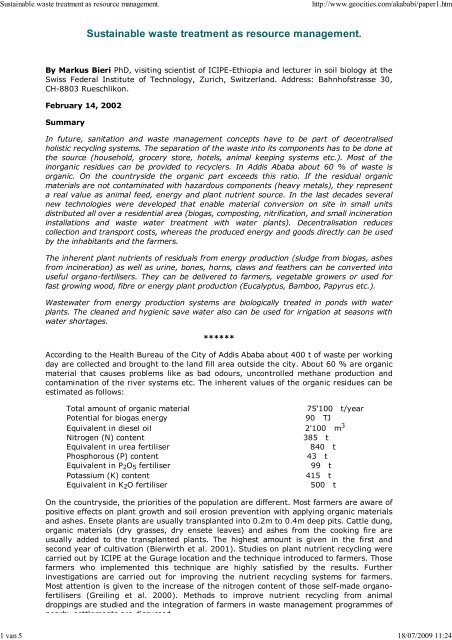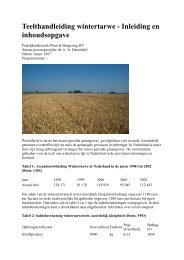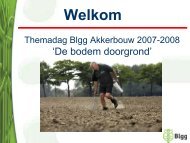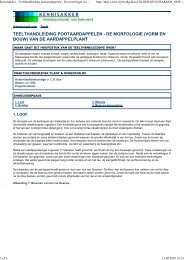Sustainable waste treatment - Conservation Agriculture
Sustainable waste treatment - Conservation Agriculture
Sustainable waste treatment - Conservation Agriculture
Create successful ePaper yourself
Turn your PDF publications into a flip-book with our unique Google optimized e-Paper software.
<strong>Sustainable</strong> <strong>waste</strong> <strong>treatment</strong> as resource management.http://www.geocities.com/akababi/paper1.htm2 van 5 18/07/2009 11:24nearby settlements are discussed.For the fast growing cities new and sustainable solutions for the inhabitants and theadministrations have to be identified. The actual centralised city sanitation installation ofEuropean and the US cities are neither economically nor ecologically efficient. The costs ofinvestments require long term planning. Whereas the installations consider high runningcosts and energy consumption. The maintenance of these plants imply the establishment ofextensive transporting and sewer systems that nowadays become a costly burden for thesesocieties.In the last years new methods, mainly based on biological processes, were found anddeveloped to convert residual materials into energy and organic fertilisers. All theseconversion processes create useful products that can marketed. Waste management underthese conditions gets a completely different image and perspective, compared to the actualstate of the art.Biological and small scale self sufficient systems are advantageous, because they can berun and maintained locally close to the end users of energy and other products. Obviouslyhe costs for transport and for sewer systems can be reduced. The converted products weighless and have a reduced volume that simplifies the transport and the distribution. Shortcircuit systems also motivate inhabitants to maintain a functioning <strong>waste</strong> <strong>treatment</strong>installation in a good shape. Decentralisation of <strong>waste</strong>water cleaning and solid <strong>waste</strong>management leads to a higher stability and security in city sanitation measures. A breakdown of a single unit does not affect the whole city. The cities however are obliged tosupervise and co-ordinate the activities of these local groups.In awareness of this situation, ICIPE-Ethiopia worked out in co-operation with ESRDF andthe city administrations of Addis Ababa, Dire Dawa and Wolkite pilot projects forsustainable and decentralised city sanitation, with the following objectives:1. Improvement of the general sanitary situation leading to better living and healthconditions of the inhabitants and the visitors of the cities.2. Creation of useful and marketable products such as biogas (energy), mats madefrom old plastic bags, card board manufacturing using paper pulp, organic fertilisers andprotein for animal feeding.3. Providing job opportunities and income generation. Including different professions inthe administration, laboratories, training sites, specialists for biogas and organicfertiliser production, specialists in <strong>waste</strong>water <strong>treatment</strong>, manufacturers of equipment’sfor <strong>waste</strong> conversion and <strong>waste</strong>water <strong>treatment</strong> systems.4. Reduction of public costs (investments and running costs) for <strong>waste</strong> management.By implementing biological self running systems with low investment and running costs.5. Build up of a decentralised organisation distributed over the whole area of the citiesto reduce <strong>waste</strong> collection and transport costs.6. Development for an efficient organisation and quality management for adecentralised city sanitation management.7. Enhancement of the international reputation of the Ethiopian Cities leading to animproved tourism industry. Ethiopia with its rich cultural heritage and natural treasuresis highly attractive to people of America, Europe and Asia.The BioFarm in Addis Ababa will be extended into a competence centre with training andeducation facilities in co-operation with ICIPE (Baumgärtner et al. 2001). Also, it willprovide scientific and technical support to city administrations and communities in allaspects of city sanitation. However, the general goal is, to establish several centres all overEthiopia. The people will regularly meet for seminars and experience exchange. Nationaland international co-operations with universities, research institutes and technical centreshave to be established.The purpose of the research group at BioFarm is to develop easy adaptable and efficientsystems for <strong>waste</strong> <strong>waste</strong>water and solid <strong>waste</strong> <strong>treatment</strong> that can be integrated intoexisting structures, built and maintained in the country. Many of these systems aredeveloped outside of Ethiopia and have to be adapted and optimised for the specificconditions and needs of the different climatic zones of this country.
<strong>Sustainable</strong> <strong>waste</strong> <strong>treatment</strong> as resource management.http://www.geocities.com/akababi/paper1.htm3 van 5 18/07/2009 11:24Optimisation of <strong>waste</strong>water and solid <strong>waste</strong> <strong>treatment</strong> includes:· Development of devices that can be made by locally made of easily availablematerials.· Identification of systems that can be run with minimum input in energy and labour.· Construction of save installations with no hazard for people, animals and theenvironment, like as fire hazards, emissions of unpleasant odours or breeding places formosquitoes or filth flies.· Production of high quality products that can be marketed, like high quality biogas,combustible biomass, uncontaminated animal feed rich in protein, nitrogen rich organofertiliserwith suppressive effects on soil borne pathogens etc.The planned technopark also serves as demonstration and training place for specialists tobe formed for maintaining and running installed systems.The following systems as integrated parts of sustainable <strong>waste</strong> management will beevaluated:1) Development of modular low cost biogas units with a high methane yieldNowadays biogas technology is a common technology used almost all over the world. InChina and India special research and development centres exist.A broad literature on biogas including the biological processes of methanisation and allkinds of designs for biogas plants is available. Most of the described biogas plants are fixinstallations with a given capacity. For further developments the design of modularstandard units that easily can be installed and transported, seems to be the mostpromising approach.In the projects of the Ethiopian cities prototypes of a standard biogas reactors forEthiopia will be planned, built and evaluated. The biogas production for different organicmaterials will be optimised.In parallel to these studies different techniques to increase the methane content ofbiogas will be evaluated. The percentage of methane in raw biogas betrays is 50 to 70percent. The rest is CO 2 with some traces of H 2 S. For both gases an efficient gascleaning procedure will be installed that easily can be implemented. The reduction ofCO 2 in the burner gas leads to a better energy output and reduces the need of storagevolume.2) Evaluation of high quality solid burner for plastic, cardboard, wood and othercombustible <strong>waste</strong>sWood, cardboard, bagasse, plastics and other combustible <strong>waste</strong>s have high contents ofcaloric energy. Today a challenge task is to find incinerators for smaller quantitiessubjected to clean burning procedure. This means an incineration process with amaximum oxidation of the materials without noxious gas and dust emissions.Low temperature distillation showed to be the most promising technique. An almostcomplete burning of the organic materials with a high-energy can be achieved. In Europemost of the newly installed wood heatings function by this principle. For Ethiopiaappropriate stoves have to be evaluated and optimised.Efficient and reliable incinerators can play an important role in energy concepts. Energyproduced with fast growing plants (e.g. Eucalyptus, Bamboo, Papyrus etc.) becomes abackbone in energy self-sufficiency, whereas combustible solid <strong>waste</strong> also serves asheating material.In co-operation with foreign universities the conversion of the caloric energy intoelectricity or kinetic energy (steam engine, Stirling engines, gas motors etc.) has to beinvestigated.3) Improvement of vermicomposting systems for high quality organic fertiliserproduction.Vermicomposting is a common composting technique that is practiced at BioFarm.
<strong>Sustainable</strong> <strong>waste</strong> <strong>treatment</strong> as resource management.http://www.geocities.com/akababi/paper1.htm4 van 5 18/07/2009 11:24Vermicomposting is a common composting technique that is practiced at BioFarm.Studies are under way to improve the nitrogen content of organo fertilisers and to findappropriate endemic earthworms. Vermicomposting systems are an integral part of the<strong>waste</strong> management <strong>treatment</strong> chain to convert biogas sludge into a marketable organicfertiliser.For the use and for marketing of organic fertilisers, quality standards have to be defined(Berner & Bieri, 1992, Bieri, 1998, Fuchs & Bieri, 2000), and a quality controllingsystem will be established.4) Production of nitrogen rich organo fertilisers.Nitrogen rich residues like feathers, claws, horns, inedible fish, residues fromslaughtering etc. but also to some extend urine, can be degraded in old compost layers.Experiments at BioFarm have shown that the amount of plant available nitrogen of suchcomposts can be highly increased.In arid zones nitrogen conservation of urine can be realised by nitrifying the inherentnitrogen. In the planned nitrifying devices nitrogen can be harvested as Ca(NO 3 ) 2, awater soluble salt, that can be added to the irrigation water in drip irrigation systems.5) Development of a <strong>waste</strong> water <strong>treatment</strong> plant in using duckweed and otheraquatic plants.In Bangladesh and in South East Asia already exist <strong>waste</strong>water <strong>treatment</strong> devices whereduckweed is used as biological agent to assimilate the nutrients from water. The systemsin this climate are highly prolific. The generated income by selling duckweed as fish orhen feed covers fully the running costs (Iqbal, 1999, Leng, 1999). The cleaning effect bywater plants also gives better results compared to actual <strong>waste</strong>water <strong>treatment</strong> plants ofEurope or US standard.In Ethiopia studies have to be carried out to evaluate suitable endemic water plants forfor <strong>waste</strong>water ponds. The goals of water plant production depend on the local situationand the actual needs. If there is a market for protein feed, protein rich plants will beproduced. Growing energy plants is also an option e.g. papyrus in arid regions. Studiesin the Sudan by O Philipp (1981, Diss. University of Hohenheim) on the utilisation of thewide spread water pest, the water hyacinth, showed that it is a suitable source for biogasproduction. Water hyacinths or water fern (Azolla) also can be used as raw material forvermicompost.References:Baumgaertner, J., Bieri, M., Buffoni, G., Gilioli, G., Gopalan, H., Greiling, J., Tikubet, G. andV. Tikubet, I. 2001. Human health improvement in Sub-Saharan Africa. CADERNOSDE SAÚDE PÚBLICA, REPORTS IN PUBLIC HEALTH. In press.Berner, A. and Bieri, M. 1991. Bericht ueber den heutigen Stand zur Beurteilung derQualiteat von Komposten (Report on quality criteria’s for composts) Bundesamt fürUmwelt, Wald und Landschaft (BUWAL) Report: 82 p.Bieri, M. 1998. Komposte fuer Landwirtschaft und Gartenbau: Qualitaetsaforderungen ausagronomischer Sicht, eine Herausforderung fuer Forschung und Komposthersteller.(Composts for agriculture and horticulture: Quality needs) Symposium on qualitycriteria for composts, ETH, Zurich: 2 p.Bieri, M., Kaufmann, R., Heller, W. and Berner, A. 1998. Qualitaets-Bestimmungen vonSchweinemist-Kompost (Determination of the quality of pig manure compost).Agrarforschung, 5: 33 – 36.Bierwirth J., Mihreteab Workineh, Abbay bekele, Greiling, J., Buerkert, A. and Bieri M.2001. Composting experiments in the BioVillage Project, Gurage Zone, SouthernEthiopia. www.wiz.uni-kassel.de/model_db/bierwirth/biovillage/compost_report.html.15 pp.Fuchs, J. and Bieri, M. 2000. Neue Pflanzentests, um die Kompostqualitaet zuCharakterisieren. (New bio-tests for compost quality assessment). Agrarforschung. 7:314 – 319.Greiling, J.,, Bieri, M., Tikubet, G., Baumgaertner, J. and Bekele, A. 2000. IntegratedManagement of Natural Resources for <strong>Sustainable</strong> Rural and Urban Development in
<strong>Sustainable</strong> <strong>waste</strong> <strong>treatment</strong> as resource management.http://www.geocities.com/akababi/paper1.htm5 van 5 18/07/2009 11:24Management of Natural Resources for <strong>Sustainable</strong> Rural and Urban Development inSub-Saharan Africa: The BioVillage Initiative. Proceedings 13 th IFOAM ScientificConference: 45.Iqbal, S. 1999. Duckweed Aquaculture, Potentials, Possibilities and Limitations forCombined Wastewater Treatment and Animal Feed Production in DevelopingCountries.EAWAG, SANDEC Report No. 6/99. 91 pp.Leng, R. A. 1999. Duckweed a tiny aquatic plant with enormous potential for agricultureand environment. FAO. 108 pp.Philipp, O. 1981. Zur Verwertung der Wasserhyazinthe (Eichhornia crassipes (Mart.)Solms) - eine zusammenfassende Betrachtung der Möglichkeiten unter besondererBerücksichtigung der bisher im sudanesischen Befallsgebiet erzielten Arbeitsergenisse.Diss. Universität Hohenheim, 180 pp.






